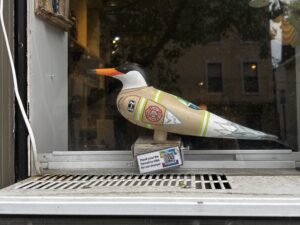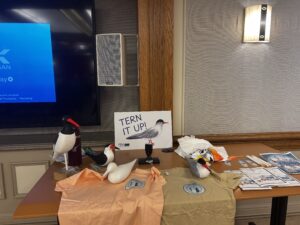
The Common Tern was designated Hoboken’s Honorary Bird in 2024. (Photo by Alex Connell)
This story was produced in collaboration with CivicStory as part of the NJ Ecology-Civics Reporting Project.
HOBOKEN, NJ – All over Hoboken in recent months, colorful birds have been spotted in storefronts in the city – nestled in local coffee shops on Washington Street or perched in local libraries on Park Avenue.
Fear not – there are no winged creatures dominating your local hubs.
These birds are decoys – artificial, often lifelike models of a certain bird species used to attract real birds and show them that an area is safe.
While the birds placed artfully around the city may not be living and breathing, they represent a very lively movement aimed at protecting Hoboken’s honorary bird and creating a more nature-friendly city.
In Hoboken, the Common Terns mate, nest, and raise their young on Pier 11 before flying back south again in the fall.
Their arrival in Hoboken less than a decade ago surprised experts and was hailed as evidence of improved biodiversity on the waterfront, thanks to the many years spent cleaning up the Hudson River, says Jeff Train, co-founder of Freedom Birders and Our Tern, two organizations focused on birdwatching and conservation.
Speaking with TAPinto Hoboken, Train said that another small city – also located on a waterfront – Honolulu, Hawaii – where activists were working to honor the White Tern, inspired Our Tern to create a similar movement.
Train explained that in Honolulu, White Terns nest in trees, and activists discovered that their nests were often destroyed accidentally by people unaware of their presence. So they devised an initiative with local government officials.
Now, in Honolulu, blue ribbons are tied around trees where White Terns nest to signal to tree cutters that they should avoid those specific trees.
Train said activists educated residents by visiting schools and colleges and reaching out to tree cutters.
“The city really embraced it because people love these birds, and because they’re so photogenic, people just fell in love with them,” he said.
Following a conversation with activists in Honolulu, Train decided that Hoboken needed “a sense of enthusiasm for ecology.”
This year, led by Train and others at Our Tern, Hoboken is nearing the end of its inaugural Tern Parade.
The Hoboken Tern Parade, organized by the group, aimed to generate enthusiasm for the Common Tern and raise awareness for its floating island project.
The parade has brought together 30 local businesses, organizations and artists to design tern decoys in “engaging, creative styles.
The parade—referring to the period when the decoy birds are displayed in storefront windows—has generated excitement and interest across the community.
Since the parade began in April, local businesses have honored the tern in unique ways.
For example, Sparrow Wine and Liquor offered customers the chance to taste 902 Brewery’s tern-inspired creation, “Our Tern on Tap.”
“It’s been a great illustration of how the local can also be global, and we never would have thought that a city halfway around the world could be connected to us here in Hoboken—and the small act they did influenced us,” Train said, referencing Honolulu activists’ efforts.
Local biking enthusiast and avid marathon runner Sofia Lichten said that on her evening bike rides or runs around the city, she started noticing more and more decoy birds.
Unaware of Our Tern’s movement, her curiosity led her to do some research.
“I had no idea we had an honorary bird,” she told TAPinto Hoboken.
Lichten said it’s made her more observant when she’s out and about. “I actively look for them now, and I’ve changed my running route so that I can be near the pier.”
TAPinto Hoboken attended an educational evening hosted by Fund for a Better Waterfront titled “As the Earth Terns” in April, where representatives from Our Tern explained how the Common Tern contributes to the ecosystem and their future plans for conservation.
Noelle Thurlow, co-founder of Our Tern and founder and director of Resilience Adventures, noted that terns contribute massively to the ecosystem in a number of ways:
- They transfer nutrients between ocean and coastal areas through their movement and droppings, which fertilize plants and phytoplankton.
- As apex predators, they control fish populations and help maintain balance in marine ecosystems.
- Their manure contains nitrogen, phosphorus and iron, which helps increase the biomass and nutritional value of plants and phytoplankton.
- Terns can carry and redistribute ocean contaminants, allowing scientists to track pollution levels by studying their feathers and droppings.
- By supporting primary producers and maintaining food chain balance, they contribute to overall ecosystem health and biodiversity.

(Photo by Alex Connell)
At the event, Train and Thurlow revealed their plans to create a modular nesting platform for seabirds like Common Terns, Black Skimmers and American Oystercatchers by summer 2026 in Weehawken Cove.
“It’s a really wonderful advertisement for ecotourism and will hopefully bring birders to the city,” Train said.
The initiative aims to attract and support local bird populations, create a research station for ecological studies and engage the community through volunteer opportunities such as water, eel and oyster monitoring, waterfront cleanups and bird censuses.
The project is inspired by successful bird conservation efforts like Steve Kress’s Atlantic Puffin Project.
Train explained that Kress discovered puffins used to nest on Eastern Egg Rock, off the coast of Maine, until the 1800s and figured someone ought to bring them back.
“He convinced the Canadian government to give him some puffins, and 50 years later, there are 184 pairs of puffins nesting there,” Train said.
Train added that, like the terns, puffins like to return to the same place, but Kress initially struggled to get them back onto the island.
“So he painted puffin decoys, put them on the island, and within days, the puffins had begun trying to court the decoys.”
Now Train is asking Hobokenites to imagine that Hoboken could have a nesting spot similar to Eastern Egg Rock for the Common Tern.
They are currently working with the Meadowlands Research and Restoration Institute to develop a flexible, modular island system that can be moved and expanded to ensure a safe place for the birds each year.
To donate to the Tern Nesting Platform Project, click here.
Catching up with Train in late May, TAPinto learned that more than 30 Common Terns had already returned to Hoboken this year and that “as soon as they appeared, they initiated courtship and nesting behaviors.”
“The Tern Parade has informed and educated so many members of our community. It’s been gratifying to see how our businesses, artists and residents have embraced these birds and the narrative they represent. The parade has cultivated positivity, and the lesson is that a little sustained effort and action can lead to a lot of meaningful change,” Train said.
Train said the floating island project is moving forward, and several of the decoys designed during the parade will be auctioned off to raise funds.
A new project is also in the works.
“It’s called the Hoboken Vagrant Ambassador. It’s a decoy that will travel the world representing the Mile Square City and highlighting the efforts of other communities working to support avian life,” Train said.
But for now, you can find out where to see the decoy designs around the City by clicking here.
This story was produced in collaboration with CivicStory as part of the NJ Ecology-Civics Reporting Project.
Co-published with TAPinto Hoboken.

Alex Connell is a 2025 CivicStory Ecology-Civics reporting fellow and writes for TAPInto Hoboken.
